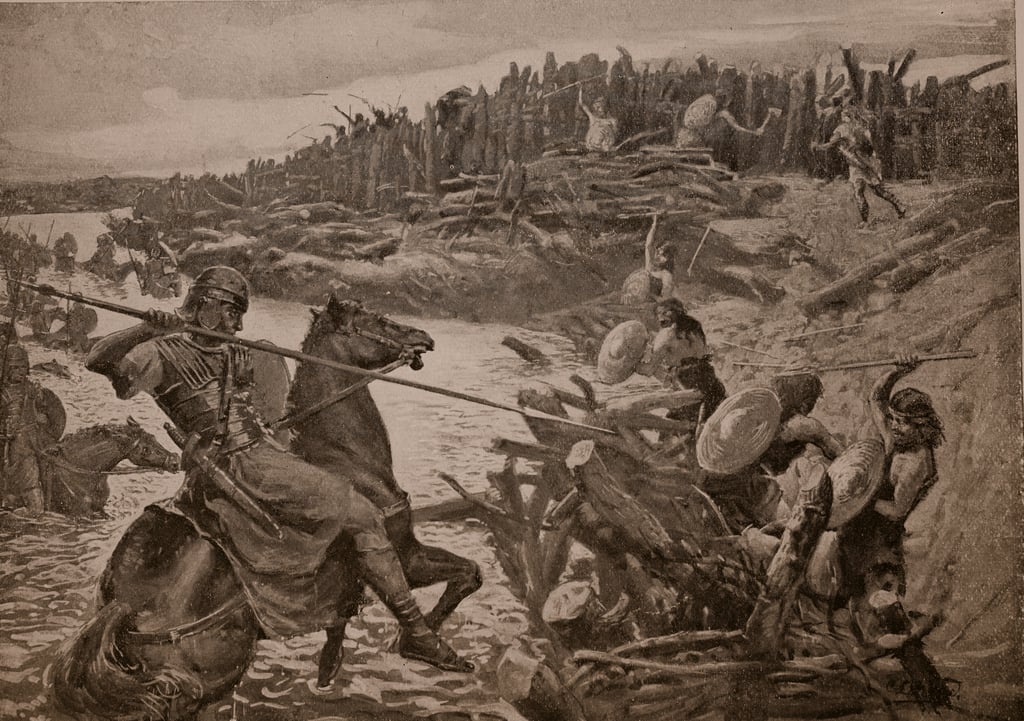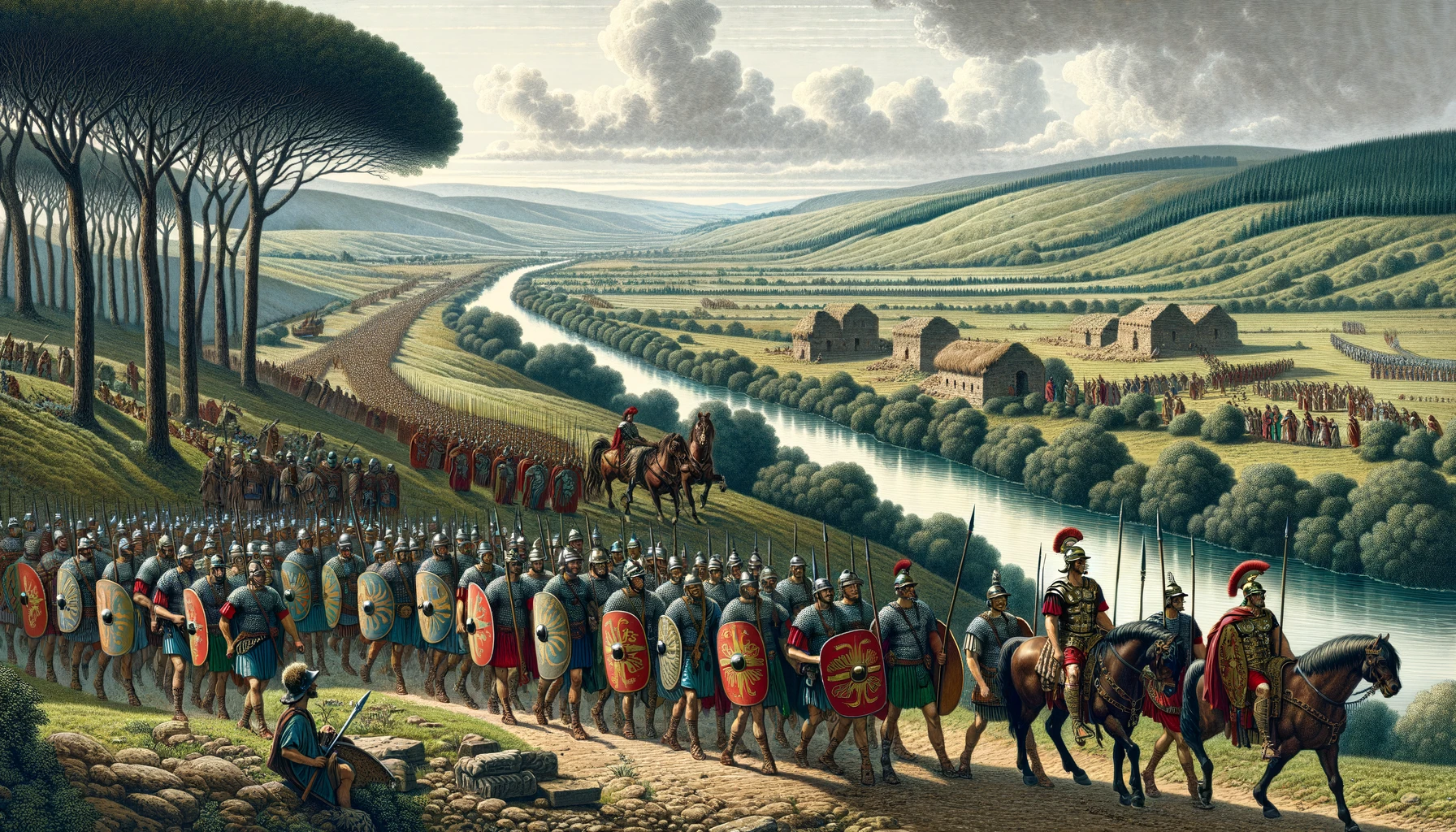At low tide what is today Tilbury and Gravesend the scene must have been a vista of mud flats through which ran several fresh water streams, the channels of which interchanged as the tides and storms scoured and shifted these alluvial deposits.
If a precise route was known to the Romans, they could have made a successful crossing. The British leader, Caratacus, would have known the route to take, and so be able to cross safely with all his remaining forces.
There are indications of a crossing point by ferry in the Middle Ages from Higham via Church Street on the Kent side to East Tilbury on the opposite shore. The Thames was very much narrower then than it is today and it is known that the tide did not reach London Bridge.
Thence the Britons retired to the river Thames at a point near where it empties into the ocean and at flood-tide forms a lake. This they easily crossed because they knew where the firm ground and the easy passages in this region were to be found; but the Romans in attempting to follow them were not so successful. However, the Germans swam across again and some others got over by a bridge a little way up-stream, after which they assailed the barbarians from several sides at once and cut down many of them. In pursuing the remainder incautiously, they got into swamps from which it was difficult to make their way out, and so lost a number of men.
Cassius Dio Cocceianus, The Histories of Rome, Book 60, Chapter 19
One fact that does seem amazing is that the Romans made use of a bridge further down river to cross the Thames. What is unusual, is the the Britons did not destroy this bridge, bearing in mind their greater knowledge of the river and how and when to cross it. Roman engineers could have built a pontoon bridge, which would easily have been brought upriver from Richborough.
It is known that Caesar, in 54 BC. had crossed the Thames with difficulty. The Britons had planned for this and fortified the North bank of the river with rows of projecting spikes, some under the waterline.

Reaching the Thames
There are conflicting beliefs where the Romans actually crossed the Thames. The most popular belief is a crossing at Brentford, although this seems too far west to be credible. The most likely place was Westminster. The reason for this is based on the path of the famous Roman built Watling Street. If the lines of this street are projected on both sides of the Thames, they meet where the Tyburn once flowed into the Thames, with another branch in the south towards London Bridge. With Rome trading with Britain before the conquest, there must have been a bridge already constructed to aid the traders in their travels. Indeed the Romans with their level of technology, could well have helped design and build it. In return for goods or services that is. The Romans did eventually build a causeway across the Thames.
The Death of Togodumnus
With the Roman advance slowing, while crossing the Thames, Caratacus had been able to rally his army and try to delay the advance to Camulodunum. The Romans had advanced this far and Claudius knew that the British had taken heavy losses at Medway.
The tribes depleted strength and fighting methods were no match against four Roman legions. Caratacus was preparing to make submissive gestures to Rome. Caratacus was now the only leader left as Togodumnus had died, probably from wounds received in the fighting. Caratacus managed to instil some confidence in his troops and there was probably a thirst for revenge, if we are to believe Dio who states that the Britons became all the more determined to resist and avenge the death of their King.
Shortly afterwards Togodumnus perished, but the Britons, so far from yielding, united all the more firmly to avenge his death.
Cassius Dio Cocceianus, The Histories of Rome, Book 60, Chapter 21
This would gain him time to make a new strategy. He had lost many of his warriors and those that did remain were weary and low on morale. Even so, he was still in the mood to carry on the war, even if his troops were not.
Claudius delays the crossing
The Emperors of Rome were leaders with egos, and this showed in the instruction Claudius had given to Plautius before his departure. Plautius was not to advance and enter the capital of Camulodunium. This was to be reserved for the Emperor himself. It was he who would lead the triumphant Roman army into the capital.
Plautius became afraid, and instead of advancing any farther, proceeded to guard what he had already won, and sent for Claudius. For he had been instructed to do this in case he met with any particularly stubborn resistance, and, in fact, extensive equipment, including elephants, had already been got together for the expedition.
Cassius Dio Cocceianus, The Histories of Rome, Book 60, Chapter 21
Plautius dispatched a prearranged message to the Emperor saying that the Britons were mounting a stubborn defence and only the presence of the Emperor himself would bring about a total victory. Plautius must have been annoyed at having to do this. He knew the pause would enable the Britons to muster greater forces He knew that if his army continued to advance, they could capture or kill Caratacus. By not advancing, he allowed Caratacus to escape with his family.
The dispatches would have been sent by a fast military courier. The post at this time would have averaged 5 miles an hour, but even if it had managed to achieve 100 miles each day, it would still have taken up to 12 days to reach Rome. Once the dispatch arrived, Claudius would have left immediately, having made his arrangements already, passing over command to Lucuis Vitellius, his fellow consul in office.
It would take 6 weeks for the Emperor to arrive, so Plautius used this time to strengthen his position in the South East. His troops could not be expected to sit around for so long. They had fought a long and hard campaign and needed something to do during this lull.
Advance to Camulodunum
[Claudius] crossed over to Britain, where he joined the legions that were waiting for him near the Thames. Taking over the command of these, he crossed the stream, and engaging the barbarians, who had gathered at his approach, he defeated them and captured Camulodunum, the capital of Cynobellinus.
Cassius Dio Cocceianus, The Histories of Rome, Book 60, Chapter 21
Did Togodumnus die?
According to Dio’s account, Togodumnus clearly dies after the battle on the Thames. However Tacitus mentions a king who ruled several territories as a loyal ally of Rome into the later part of the first century, called Cogidumnus in most manuscripts but Togidumnus in one. They may be the same person if you consider that Dio may have been mistranslated and instead of dead, Togodumnus may have, lost (amisso).
Some of the states were given to king Cogidumnus [Togidumnus?], who lived down to our day a most faithful ally. So was maintained the ancient and long-recognised practice of the Roman people, which seeks to secure among the instruments of dominion even kings themselves.
Cornelius Tacitus – Agricola, Chapter 14
A damaged inscription, naming him “..gidubnus”, places him in Chichester.
RIB 91 - Altar dedicated to Neptune and Minerva
To Neptune and Minerva, for the welfare of the Divine House by the authority of Tiberius Claudius Togidubnus, great king of Britain, the guild of smiths and those therein gave this temple from their own resources, Pudens, son of Pudentinus, presenting the site.
TEMPLVM
[...]O SALVTE DO[...] DIVINAE
[...] AVCTORITAT[ ...] CLAVD
[...]GIDVBNI R[... ]AGNI BRIT
[...]GIVM FABROR ET QVI IN EO
[...]Ṭ D S D DONANTE AREAM
[...]ENTE PVDENTINI FIL
Pro salute domus divinae is a very rare formula; see note to RIB 89.Cogidubnus: see 14 quaedam civitates Cogidumno regi donatae.r(egis) (et) legat(i) Aug(usti) in Brit(annia): on this title, which is characteristic of Claudius’ ‘tendency to mingle innovation with conservatism’ see Collingwood and Myres, Roman Britain and the English Settlements (1936) 86.qui in eo [sun]á¹ Huebner suggests that this phrase comprises members who joined in meetings of the guild without possessing all its privileges.Waltzing, Corporations iv 267 lists this phrase among those which indicate membership of a guild, but does not suggest that it implies any difference in status: cf. CIL xii 1929 scaenici Asiaticiani et qui in eodem corpore sunt.
Caratacus leaves for Wales
The Britons were presumably puzzled as to why the Romans had stopped, but would have used thier time to consolidate. In the far West, further towards and into what is now Wales, the hill folk, encouraged by the Druids, were determined to carry on the fight. They saw Caratacus as the only leader that could muster the Western Tribes into fighting against the Romans and so offered to protect him. Caratacus and his followers said good-bye to their fellow compatriots and made their way west to Wales and the safety of the Druids.
Vespasian is sent to the South-West
Plautius decided to send Vespasian and the Legio Secundae Augusta to the South West against the Durotriges Tribe who were busy fortifying their defences and Hod Hill and Maiden Castle. This would not only keep his troops active, but also enable him to gain more territory without disobeying the instructions from Rome.
The fleet would be able to anchor off the beach at Bosham Harbour (Magnus Portus) to provide logistical support. The Britons were expecting a land based assault, but Plautius knew a sea approach would take the western tribes by surprise. Plautius could not commit a large contingent of soldiers to this venture as the Britons could well regroup and launch attacks. He could only send one force, Legio II Augusta with Vespasian as the commander. The remaining forces would be needed for the great display that would be involved once the Emperor arrived. There would also be time to recall one of his Generals, Vespasian to be presented to Claudius in this, their great triumph.
Meanwhile Vespasian and his legion were moving South West through Britain taking land as they went. Suetonius wrote of them fighting 30 battles, defeating two hostile tribes, taking 20 oppida and the Isle of Wight. (insulam Vectem). Vespasian went as far west as Devon, but stopped short here as the tribes to the west were pro Roman, and so did not need to overcome at this point.
